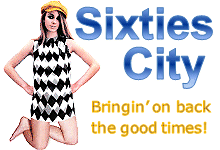


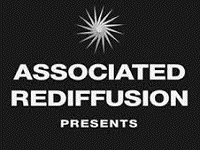
  |

|
 |
| This iconic pop music
show with its unforgettable slogan, 'The Weekend Starts Here!', was screened
on Friday evenings from 9th August 1963 until 23rd December 1966. Keith
Fordyce, previously involved with ABC's 'Thank Your Lucky Stars', was the
main compere of the show which was mainly co-hosted by the demure 'Queen
of the Mods' Cathy McGowan. Other additional presentation was supplied by
David Gell, Michael Aldred and (twice) Dusty Springfield. RSG! was particularly
noted, at the time, for allowing artists to perform the full version of
their songs when other shows insisted on 'short' versions. Despite massive popularity in the UK, the programme was never taken up by American television, possibly due to its being a black-and-white production at a time when the major U.S. television networks (ABC, CBS and NBC) were in the process of converting to colour broadcasting. The 30-minute 'live' music show, devised in the summer of 1963 by Elkan Allen, was an initiative by the Associated-Rediffusion television company (renamed 'Rediffusion' in 1964) intended to take advantage of the fast-growing 'British beat boom'. Vicki Wickham, (who was Dusty Springfield's secretary and, later, manager) is credited with the concept of specifically aiming it at a 'mod' audience. Initially, a trial 'pilot' show (featuring The Springfields) was carried out at The Royal in Tottenham, London, to give the production team some idea of what to expect from such an undertaking. Their early intentions were to present the main show to an audience of about 150 inside their London studio at Television House, Kingsway, where compere Keith Fordyce would introduce the artists, with additional activity in the lobby where his Canadian co-host, David Gell, would chat with audience members about their personal current favourites. Other ideas for show content bandied about at the time included: selection of one of the invited audience members to be an amateur disc jockey; giving someone the chance to win that week's Top 50 singles; blindfolding members of the audience and getting them to try and identify a current chart hit; and having a weekly section with 'showbiz' news items. Thankfully, all these were dropped and the production concentrated largely on the artists and dancing inside the studio itself. |
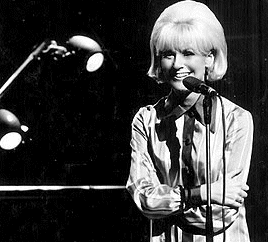 |
        |
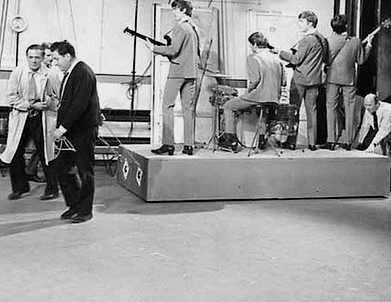 |
Artists performed
on various 'mini' stages, studio gantries and staircases or, in the case
of solo artists, on the main studio floor in very close proximity to the
audience and cameras. Some of them even danced among the audience when not
performing themselves. The original producers were Francis Hitching and
Elkan Allen. Robert Fleming was the first director, with later direction of the show being shared, at various times, by Peter Croft, Rollo Gamble, Daphne Shadwell and Michael Lindsay-Hogg. The famous RSG! spiral logo was created by Arnold Schwartzman who was responsible for all the show's graphics, including the title sequence. Michael Lindsay-Hogg recalled: "In the days before e-mail it was so much easier to lie. I'd worked in Irish TV and told Rediffusion I'd directed lots of stuff. They didn't call anyone to check. At first, Ready, Steady, Go had a rotating group of older directors who were more interested in Shirley Bassey than The Rolling Stones. When one went on holiday, I made it my business to bump into Elkan and got the job of filling in. The week I was due to leave, they had The Stones and The Animals on. I said to Elkan "Give me one more week and I'll give you the best rock'n'roll show you've ever seen." He liked that crazy confidence and let me take over as director." Series editor Vicki Wickham recounted: "Ready Steady Go! was dreamed up by Elkan Allan, head of light entertainment at Rediffusion TV in 1963. He got a bunch of young people together who knew nothing about TV and gave us our heads. I came from BBC radio and didn't have a television at home so I'd never even seen pop on TV. My job title was editor but I was actually booker, producer, tea girl, everything. By the time we went on air, I knew how to get hold of The Beatles and The Rolling Stones". "Elkan came up with the slogan 'The weekend starts here' and we went through several theme tunes until we settled on Manfred Mann's 5-4-3-2-1. The Springfields played in the pilot, then Dusty ended up presenting. It was a great endorsement, but was always going to be temporary because her singing career came first. After Dusty left, we advertised for a 'typical teenager' and Cathy McGowan became the face of Ready, Steady - after telling Elkan the most important thing to her was fashion!" Cathy McGowan was working in an office at the television company when she answered an advertisement for a 'typical teenager' to act as a 'youth advisor' to the show and was thrust, without any previous experience whatsoever, in front of the cameras as one of the main presenters. George Harrison described her as '....the posh bird who gets everything wrong' ". |
| The original theme
tune used was 'Wipe Out' by The Surfaris. This title
sequence was soon replaced by Manfred Mann's classic '5-4-3-2-1' and
subsequently by other songs including Manfred Mann's 'Hubble Bubble, Toil
and Trouble', Dusty Springfield's 'Heartbeat', The Animals' 'I'm Crying'
and Wilson Pickett's 'Land of A Thousand Dances', among others. The audience was chosen from London clubs where the best, or the most fashionably-dressed, dancers were given ticket invitations to the next show. Vicki Wickham recalled: "Cathy and I chose the crowd by going to clubs like the Revolution, or the Speakeasy, and picking people we thought looked great and could dance." The first show was broadcast on 9th August 1963 from Television House, Kingsway, London, at 7:00p.m (although some regions delayed transmission time to a late evening slot at 10:40p.m.). The live acts, performing in front of about 200 teenagers, were a curious mixture of musical talent that included Billy Fury, Brian Poole and The Tremeloes, Joyce Blair, Joe Loss, Burl Ives and Pat Boone, not all of them exactly what might be described as 'mod' music icons! At that time, the 'open set' was a popular directorial concept where the entire studio was visible to an aerial camera that captured the views that the show always started with. After a high shot showing the audience dancing the view would cut to a floor-level camera, moving in on presenter Keith Fordyce for him to deliver his regular "Well, hi there!" intro. The usual show format featured a combination of new releases and existing hits plus off-the-cuff interviews with some of the artists, usually carried out by Michael Aldred or Gay Singleton. In October 1963 Helen Shapiro made an appearance performing the song 'Look Who It Is' in a sequence with three of The Beatles. When asked why only three of the four Beatles (facing away from the cameras until she turns them around) she advised "The song had just three verses, so only three of them could appear. They flipped a coin, or something, to see who would be on, and Paul came up short." In the shows broadcast from the small Kingsway studio facility, all the appearing artists mimed to recordings of their records. With its growing popularity, Kingsway started to experience difficulty in catering for, or controlling, the hundreds of fans who always crowded around the outside of the building and the show was eventually moved to Studio 5 at Wembley (now Fountain) studios in April 1965. The move to the larger Wembley facility allowed more scope for the artists to perform live and, with the use of pre-recorded backing tracks now being prohibited by the Musicians' Union, the whole of the studio (usually split into 5a and 5b) had to be utilised so that an in-house orchestra could be brought in to play the backing music. The space provided by the combined studio was 14,000 sq ft making it, at the time, the largest purpose-built TV studio in the world. |
 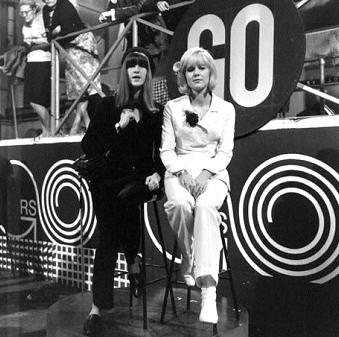 |
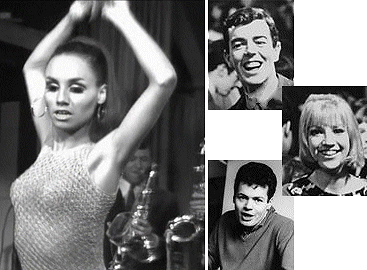
|
The resident full-time dancers
appearing on the show were Theresa Confrey and Patrick Kerr who demonstrated
new dances alongside 'members of the public' (whom they chose specially
from their visits to the Sabre club), with a certain Paul Raven (better
known in the next decade as Gary Glitter) acting as the 'warm-up' man for
the studio audience. Patrick and Theresa had previously been teaching dancing on a cruise ship and were hired by the programme producer at the time to perform some of the latest dances they had picked up while in the USA. In 1964, Kerr left the show for a brief run as a pop singer, but then returned as a co-presenter with Cathy McGowan. Pop artist Pauline Boty was a dancer on Ready Steady Go! and another dancer regularly appearing was Sandy Sarjeant, who was something of a local celebrity in the London 'mod' scene. Sometimes known as 'Crazy Legs', she was in the habit of creating her own modifications to dance moves that made it difficult for other dancers to copy what she was doing at any given time. She released a single in Germany titled 'Can't Stop The Want', went on to appear in the 1967 film 'Bedazzled' and became the lead dancer on the German pop show 'Beat Club'. In 1968 she married the Small Faces' keyboard player Ian McLagan and can be seen in their video for the 'Itchycoo Park' single. Whatever Happened To Sandy Sarjeant On 3rd October 1964, the pop magazine 'Fabulous' produced an issue called 'Shaking London Town' that featured a spread about Ready Steady Go! and Vicki Wickham's 'POP guide to London' which featured hairdressing salons, recording studios, clubs, mod shops and the Fabulous offices. Ready Steady Go launched its own magazine in 1964, costing 2 shillings and, in the same year, a spin-off television series featured the RSG team in a show called 'READY STEADY WIN', searching for new pop talent. Needless to say, the show immediately became known as 'RSW' with that logo being visible on the studio cameras. The 'regular' judging panel included Brian Epstein, Bill Haley and Brian Matthew plus guest judges each week, including Ringo Starr, Brian Jones and Mick Jagger. Harbour Lights at Ready Steady Win Bo Street Runners at Ready Steady Win |
| An American show
called RSG! USA! was produced by Dick Clark during 1964 but an infringement
of trademark caused it to be axed after just six episodes. The original
UK production gained its highest viewing ratings on 20th March that year
when it featured The Beatles, performing 'It Won't Be Long', 'You Can't
Do That' and 'Can't Buy Me Love', as well as being interviewed live. That
particular show also starred Dusty Springfield, Bobby Vee, The Animals,
Alma Cogan and Millicent Martin. With the growing increase in popularity the show was extended and moved to a 50 minute slot starting at 6:08 p.m. By the end of its second year, Ready Steady Go! had been the vehicle for a large number of television debuts. The Beatles, The Rolling Stones, The Yardbirds, The Searchers, The Pretty Things, The Kinks, The Animals, The Who, Manfred Mann, Sandie Shaw, Donovan, The Walker Brothers, Cilla Black, Lulu, The Springfields and Jimi Hendrix all made British television debuts, of various types, on RSG! The Beatles first appeared on the 4th October 1963 show with Paul McCartney judging a contest between four teenage girls miming to Brenda Lee's 'Let's Jump the Broomstick'. The winner, 13-year-old Melanie Coe, made the headlines in The Daily Mirror when she subsequently disappeared. Three years later, McCartney immortalised her in the song 'She's Leaving Home'. The thirty-sixth episode of season one, released on Wednesday 8th April 1964, featured the Ready Steady Go 'Rave Mad Mod Ball', 30 minutes of a charity show broadcast from the Empire Pool, Wembley. Apart from The Beatles - who that week were celebrating attaining the top five records in U.S, the show featured The Merseybeats, Billy J. Kramer and the Dakotas, Freddie and The Dreamers, Cilla Black, The Searchers, The Fourmost, Manfred Mann, Kathy Kirby, The Rolling Stones, Kenny Lynch and Sounds Incorporated. In early 1965 the Musicians' Union threatened to 'black' the show if the lip-synch miming to recorded music wasn't stopped by 31st March, so April 1965 saw a temporary name change to 'Ready Steady Goes Live' to highlight the fact that, for the first time, all the artists were actually singing, and performing to live backing music. |
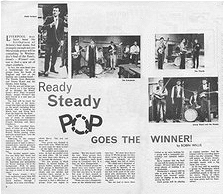 |
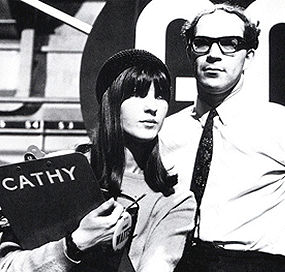 Arnold Schwartzman and Cathy McGowan 1964 |
Dusty Springfield conceived and
introduced the RSG 'Motown Special' during April that featured Stevie Wonder,
The Miracles, Martha and The Vandellas and in which The Supremes performed
their 'Stop! In the Name of Love' dance routine for the first time. During
this period David Goldsmith co-hosted the show with Cathy McGowan during
Keith Fordyce's absence. Cathy McGowan became the prime presenter when the
show reverted to its original title on 4th June 1965, but Fordyce returned
to present the 1965/66 New Year's Eve show. 1966 saw several of the shows being hosted by 'special guest presenters' who would both perform their own music and introduce the other acts. These 'specials' included The Troggs, The Who, Otis Redding, The Walker Brothers and Ike & Tina Turner. The Who's 'special' was titled 'Ready Steady Who'. Unfortunately the recording no longer exists although an EP with the same name was issued, but not taken from show recordings. Only fragments of The Walker Brothers show still exist and can be seen on You Tube. On Friday 1st April 1966 an episode called 'Ready, Steady, Allez!' was broadcast live from The Locomotive Discotheque in Paris. The show continued throughout 1966 but, despite its prime-time placement, with production costs rising and competition from the BBC's 'Top of the Pops' causing the viewing numbers to fall, it was re-scheduled by Rediffusion and finally ended on 23rd December 1966, with the last show being titled 'Ready Steady Goes!'. The show's famous 'Weekend' tag-line was revived by London Weekend, in 1968, to announce their opening programme line-up. Michael Lindsay-Hogg: "Most of the shows were wiped because tape was so expensive, so stuff like the James Brown special and The Who special are gone forever. I took home £37 a week but, every so often, I'd buy a video tape and preserve it. It cost me £1 a minute, but the only reason any shows survive is because I did that." Sixties pop star and entrepreneur Dave Clark bought the few remaining recordings of the shows from Rediffusion in the mid-Seventies, plus an assortment of other non-RSG! pop 'specials', and started to release them through home video, Channel 4 television in Britain in the mid-Eighties. In late 1989 they were also shown on the Disney Channel in America. According to 'LostShows' out of an original total of 178 episodes, 170 episodes are missing and a further 3 are incomplete. |
     |
|
|
All
Original Material Copyright SixtiesCity
Other individual owner copyrights may apply to Photographic Images |